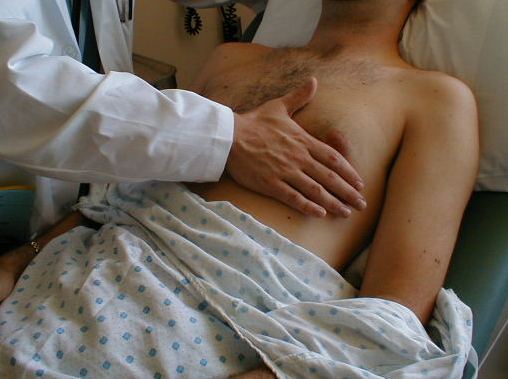Palpation of the precordium
| Palpation of the precordium | |
 | |
|---|---|
| Palpation of the Precordium. Image courtesy of Charlie Goldberg, M.D., UCSD School of Medicine and VA Medical Center, San Diego, California |
Editor-In-Chief: C. Michael Gibson, M.S., M.D. [1]
Overview
Palpation of the precordium involves placement of the palm on the anterior chest wall to assess the size of the heart, to assess for the presence of a heave or lifting of the chest, and to assess for the presence of a thrill or disturbed blood flow.
Point of Maximum Impulse (PMI)
The point at which the ventricular impulse is most prominent normally is at or near the 5th intercostal space in the mid-clavicular line. In obese patients or in patients with hyerinflated lungs and emphysema, the apex may be diffcult to feel. If it is difficult to palpate the apex, a search should be made laterally and inferiorly in case cardiomegaly is present which can significantly displace the PMI. If after a vigorous search of the left side of the chest no impulse is found, a search should be made on the right side in case dextrocardia is present.
The PMI should be described by the following characteristics (which can be remember with the mnemonic SALID:
- S - Size - Is it larger than one interspace?
- A - Amplitude - Is it weak?
- L - Location - Is it in the fifth intercostal space at the mid-clavicular line?
- I - Impulse - Is it monophasic or biphasic?
- D - Duration - Is it abnormally sustained?
The best way to describe apex beat is the point that has the most lateral and most inferior of apex pulsation.
Heave
A heave is felt as an upward displacement of the chest against the hand. Heaves are best felt with the heel of the hand at the sternal border.
Thrill
A thrill is a palpable murmur, and feels similar to a cat purring. The tips of the fingers may be more sensitive to this vibration.
Clinical Pearls
After identifying the rough position with the palm of your hand, try to pin down the precise location with the tip of your index finger. The normal sized and functioning ventricle will generate a penny sized impulse that is best felt in the mid-clavicular line, roughly at the 5th intercostal space. If the ventricle becomes dilated, most commonly as the result of past infarcts and always associated with ventricular dysfunction, the PMI is displaced laterally. In cases of significant enlargement, the PMI will be located near the axilla. Occasionally, the PMI will not localize to any one area, which does not necessarily indicate ventricular enlargement or dysfunction. Obesity and COPD may also limit your ability to identify its precise location. Palpating while the patient is in the left lateral decubitus position can make the PMI more obvious.
What is the duration of the impulse?
In the setting of hypertension or any other state of chronic pressure overload, the ventricle hypertrophies and the PMI becomes sustained (i.e. you feel the impulse for a longer period of time). This is actually pretty subjective and can be tough to detect. Note that hypertrophy and dilatation are not synonymous. They can exist separately or in conjunction with one another.
How vigorous is the transmitted impulse?
Processes associated with ventricular hypercontractility (e.g. compensated mitral regurgitation or aortic insufficiency that result in exceptionally large stroke volumes) generate an impulse of unusual vigor.
Do you feel a thrill, a vibratory sensation produced by turbulent blood flow that is usually secondary to valvular abnormalities?
The feeling is similar to that produced when you squeeze on a garden hose, partially obstructing the flow of water. The location of the thrill will depend on the involved valve (e.g. thrills caused by aortic stenosis are best felt toward the right upper sternal border). If a loud murmur is detected during auscultation, you may then go back and reassess for the presence of a thrill. In general, thrills are an uncommon finding.
Palpation of the precordium in a female patient
Palpation of the precordium of a female patient is best done by placing the palm of your right hand directly beneath the patient's left breast such that the edge of your index finger rests against the inferior surface of the breast. Make sure that you tell that patient what you are about to do (and why) before actually performing this maneuver. Remember that with age tissue turgor often declines, causing the breasts to hang below the level of the heart.
Videos
General cardiovascular exams including evaluation of the heart sounds and palpation of the precordium are shown below: {{#ev:youtube|dp5m2tXHDmA}}
{{#ev:youtube|hXU24g95wJU}}
{{#ev:youtube|-8Hi1PjZam4}}
{{#ev:youtube|MIfmjFG6BTQ}}